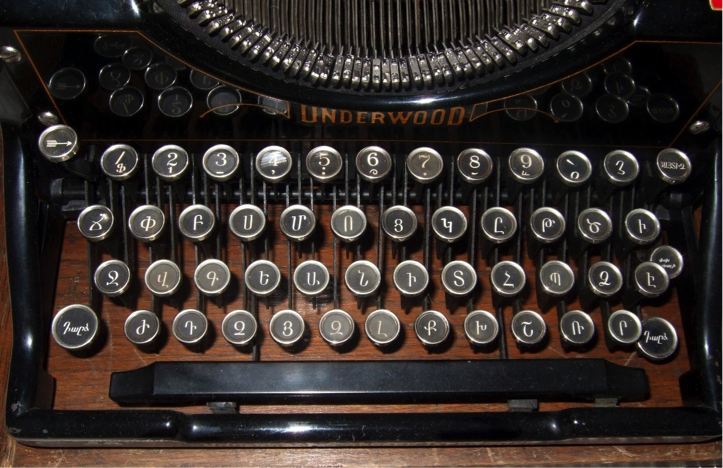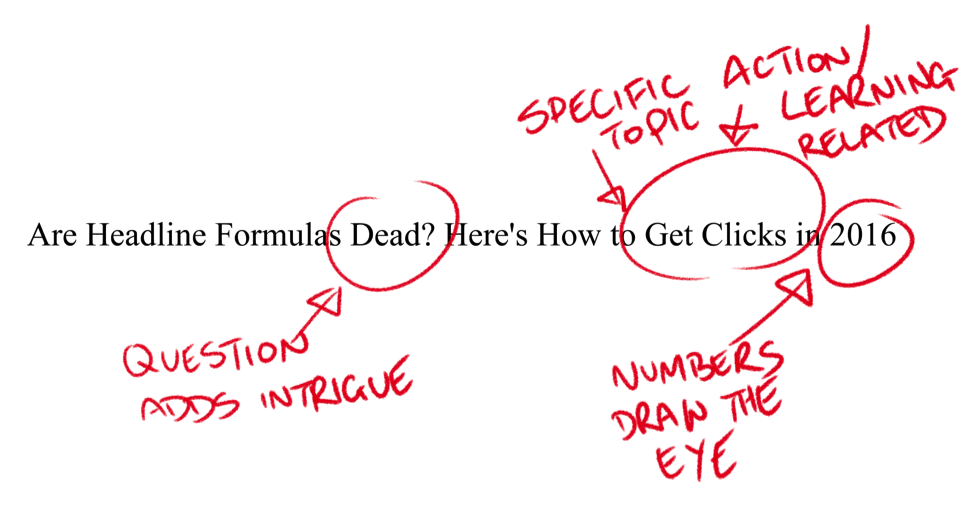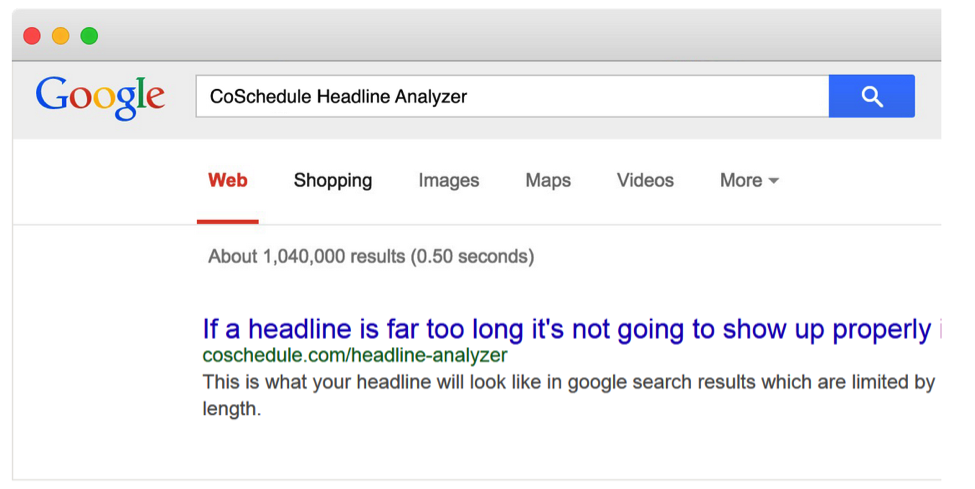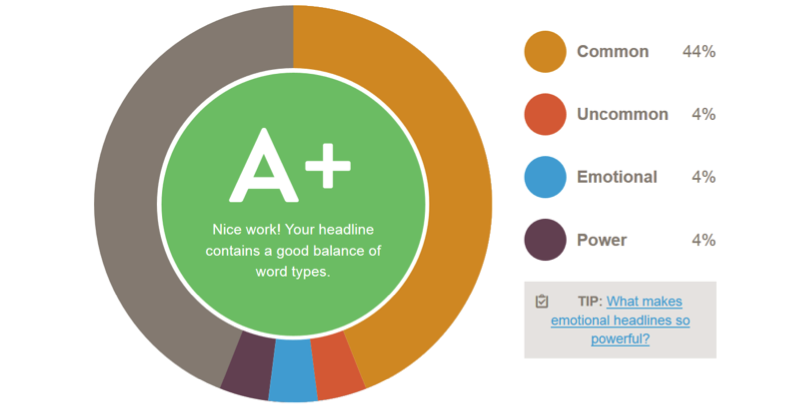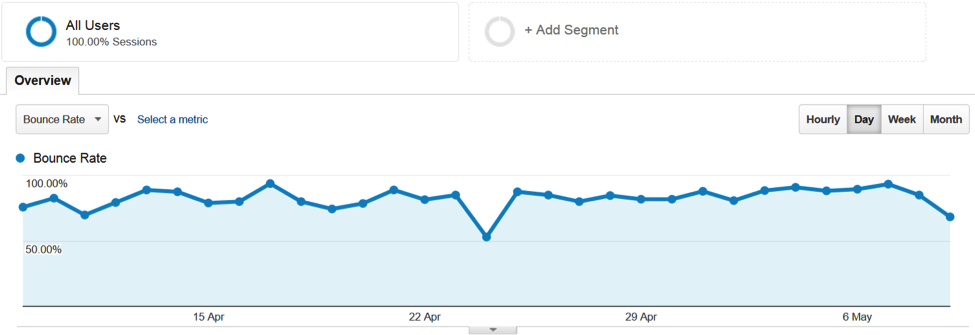Headline formulas are dead. Long live headline formulas.
- Once upon a time, internet marketers settled on the idea that a carefully scripted headline could draw significantly more traffic to a site.
- These marketers worked hard to create the perfect script, or combination of words and themes, that would draw in visitors to their websites.
Over time, though, these scripts have lost their flavor. As audiences have become more savvy, instead marketers have turned to shock tactics to draw in audiences.
This approach to headlines has come to be known as clickbait, and it’s generally considered a dirty tactic.
But do you know what?
Clickbait works.
It works really, really well, in fact: scientific studies have proven conclusively that internet users can’t help but click on evocative headlines.
There’s just one problem: while carefully worded headlines still work wonders, internet users are beginning to get sick of the clickbait approach.
- Using titles that toy with your audience or misrepresent your content will annoy your audience, who will trust your site less as a result
- Getting visitors to your site is great, but clickbait practices are a path-of-least-resistance method that’ll see most users disappear as soon as they’ve arrived on your site.
Two Headline Approaches That May Shock You
The above is an example of a clickbait headline that you should avoid.
- There’s still a lot that can be gained from having a well-written headline
- But sticking too strictly to any one formula is going to hurt your site’s reputation and won’t attract the kind of visitors who are likely to convert into leads.
Instead, I’d recommend looking at headlines from two approaches:
- The artistic approach: headlines should be well-crafted to feature the words and phrases that will appeal to readers without annoying them
- The scientific approach: headlines should be analyzed and assembled using statistical research to be as effective as possible.
By combining these two approaches, you can create headlines that will attract the largest possible audience without relying on the kind of formulas that put off site visitors.
The Artistic Approach:
Ultimately, headlines are meant to communicate something.
- They need to tell your potential visitors that your content contains a unique, interesting, and worthwhile message
A dull headline won’t catch anyone’s attention: instead, you should treat your headline like a work of art, designed to appeal to the user and inspire action in them.
Use Bold Language
With all the exciting, interesting and important content on the internet, it’s getting increasingly difficult to convince audiences that your content is worth their time.
- No matter how good your content might be, if you’re not selling it through your title, nobody’s going to come look at it.
To make sure people actually pay attention to your headline, you want it to be memorable:
- Use evocative, action-oriented words to describe what’s in your article.
- Create a sense that your content will help people to learn to do something specific.
- Asking questions helps to create a sense of intrigue in readers who want to know the answer.
In addition to all of this, it’s proven that numbers in particular help to draw in the eye, whether they’re:
- Dates
- Lists
- Statistics
This has led many creators to shape their content around the numbers or the key facts and learning that comes from their content.
- List articles are particularly popular because they give the impression that the content is quick, easy to digest, and yet full of specific, impactful knowledge.
- These are the kinds of qualities you want your headlines to communicate in order to establish your brand as authoritative and worthwhile, instead of just trying to grab attention.
Make your headlines snappy and bold, and readers will naturally want to know more about your content.
Speak to Your Audience
As important as it is to help your titles to draw in a wide audience, this isn’t the most important goal for content marketing.
- Most crucial is drawing in the right people.
- If your content is bringing in a wide audience of visitors who won’t ever convert because they’re not interested in your products, your content marketing efforts are wasted.
Really clever headline design isn’t just based on shocking readers into clicking on your links.
- You want to use your headlines as a way to weed out time wasters while appealing directly to the audience that will be interested in your brand.
One of the most effective ways to do this is to lead with industry-specific learning.
- Tell users what interesting facts or figures stand at the heart of your content right in the title, and they’ll be interested to learn more about the research behind this discovery.
Remember how I said that numbers are eye-catching and appeal to readers?
If your content is based on a piece of research, put the key finding right in the title (preferably with a quantifiable numeric).
- Readers will click your piece to learn more about how this has been discovered.
A lot of the trick to drawing in the right audience for your content is knowing what topics they care about, and filling your titles with references to how your content has learned important information about these subjects.
Readability Is Key
Imagine internet users are scrolling through a long list of content when they come across the headline to one of your articles.
- This reader has a thousand other distractions in front of them which could lead them to skip past your article.
- To get the best response, you need to make sure that the reader understands what your article is about instantly, without having to work too hard.
Writing a readable headline might sounds easy, but it’s surprisingly common for creators to trip up on this step.
A good, well-written headline:
- Uses simple phrases and words that can be understood quickly
- At the same time, uses enough unique or unusual words to draw the reader’s eye and make the content stand out.
The balance between simplicity and uniqueness is difficult to get right.
Many writers try to create clever or catchy titles that are a little too difficult to understand, meaning that readers won’t know what’s going on and will keep scrolling rather than pausing to read the article.
Many headlines experts recommend relatively short titles, for several reasons:
- A shorter title cuts down the amount of time it takes to read and understand the message of the article.
- Shorter titles mean ranking higher in search engines for relevant keywords as it’s clearer what your article is about.
- Crucially, character cut-offs for social media or even search engines can mean that only part of a longer title will display, which means readers can’t read your whole headline, and can’t find out what your content is about.
Keeping titles short, concise, relevant and easy to read is a big step towards getting people to pay attention to the headline long enough to want to know more.
The Scientific Approach:
As useful as the artistic approach to headline generation is, it’s easy to end up falling into bad habits if you don’t know what is actually going to appeal to readers:
- While one type of headline might work for a certain audience, it’s often difficult to nail down the best approach for your potential customers.
While there’s a lot of room for personal interpretation with the more artistic steps to headline generation, with analysis, the scientific approach can produce concrete ways to improve your headlines that are unique to your own subject and audience.
Because of this, I also recommend combining bold language and readability with an analytic approach, using statistics to drive headline design.
Make Use of Tools
Considering the thought and effort that various marketers have put into headline generation over the years, it’s not surprising that there are a lot of analysis tools that you can use to rank and improve your headlines.
Entering your headline into the Hemingway App will give you a breakdown of your title, and ways that it can be improved to produce a more powerful introduction to your content.
- You can use this tool to weed out any elements of your title that might hold you back.
Similarly, CoSchedule has a fantastic headline analyzer tool that gives a very thorough breakdown of what’s scientifically proven to either work or need fixing in your titles.
You can put both of these tools to work to carefully tweak your headlines to ensure that your title is as provocative and eye-catching as possible.
Just remember, though: your titles are designed to be read by humans, not machines. So while these analytical tools might recommend a particular format of headline, it’s no guarantee that a human reader will find it appealing.
Use these tools to improve your headlines, but default to your own best judgement if they suggest something that you don’t think works very well.
Keep an Eye on the Stats
All of the theory behind a headline formula might be useful, but this will provide limited insight into what works specifically for your customers.
- After all, you want your headlines to draw in a very specific crowd of people who will generate business for your company, and they might have different needs to the wider internet audience.
To get a better idea of what headlines are working well, it’s useful to look at your own content and how well it’s performing.
Google Analytics provides a breakdown of how much traffic each page on your site is receiving.
- You can use this breakdown to spot which headlines are drawing in audiences.
- From this you can not just spot which words or phrases appeal to your audience, but also which topics you should be mentioning in titles and what direction to take when publicizing your content.
What’s more, using Google Analytics you can get an idea of the bounce rate for each page on your site.
- If your headline is drawing people in but they’re not sticking around, then as successful as that headline might appear, it’s pulling in the wrong audience.
Use analytics tools to identify headlines that are holding people’s interest, and write more headlines that match the way these are written.
A/B Test to Get the Best Results
If you use split testing tools, you’ll be able to get an even better understanding of what works for your headlines, and you can even pinpoint the perfect headline for each individual article.
A/B testing involves writing multiple headlines for a single article and then letting a computer program display different headlines for different users.
- The more popular headline is then chosen as the default one, making sure that your headline is the perfect choice.
- You can then use this mathematically chosen headline as the basis for future headlines to help make sure you always get the perfect headline for your articles.
When A/B testing headlines, it’s important to remember the other points on this list:
- The computer can’t write headlines for you and can only display titles that you personal write for it.
- You need to provide it with well-written headlines that’ll draw in users’ attention by appealing with strong language and an engaging, interesting subject matter.
Ideally, you should be generating a series of well-crafted headlines for each article, and then pitting them against each other in a split test to find the perfect way to draw readers to your website.
You Won’t Believe How Great These Headlines Are!
Ultimately, as I said above, while formulaic headlines are losing their popularity, clickbait really works.
- If you can find ways to make evocative, enticing headlines that don’t overly annoy or put off your audience, you should use them.
- That said, be sure that your headlines appeal to the right audience so that you don’t cast a wide net full of disinterested users.
Through combining the artistic and scientific approach to headlines, you can create titles for your content that will inspire an interest in your content, whilst helping to grow the reputation of your brand.
What headline practices do you use to draw in readers? What’s your opinion on clickbait practices? Leave your thoughts in the comments below:
Images: Pixabay, Pixabay, Pixabay, Wikipedia, Wikimedia Commons, Wikimedia Commons, Pixabay, CoSchedule, Pexels, CoSchedule, Google Analytics, Wikimedia Commons, Pixabay.





